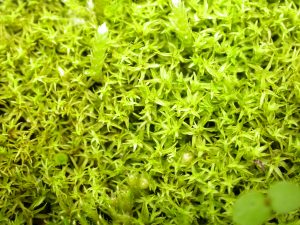Situated in 59 acres, the house at Saint Hill was built in 1792 and has had many owners, including the Maharajah of Jaipur, who sold it to L. Ron Hubbard, the founder of scientology, in 1959. The grounds include some nice woodland, especially around the landscaped lake, including many damp and shady areas with sandstone stonework. I visited the site today with county bryophyte recorder, Tom Ottley.
Starting off in the gardens adjoining the house, there was plenty of Didymodon vinealis on the stonework around the edge of the beds. Tom noted that it is not crisped when dry, in contrast with D. insulanus, and we could also compare it with D. sinuosus on the vertical edges of the steps, with its wavy leaf edges. Much of the stonework was also covered in the velvety Rhynchostegium confertum.
One of the trees was host to Zygodon viridissimus, which has slightly narrower leaves which are lightly recurved when wet and lightly twisted when dry, in contrast to Z. conoideus, though it is a bit subtle. There weren’t that many epiphytes, but we found several Orthotrichums: affine, lyellii, pulchellum, and striatum, the latter with its pointed leaves and distinctively-coloured peristome teeth. It used to be common in Sussex a century ago, but its population declined as sulphur dioxide levels rose, though it has now come back as pollution levels have decreased, especially since 2000.
Most of the rest of our visit was around the edge of the lake with its nice bed of Bulrush (Schoenoplectus lacustris), which was also an opportunity to be periodically distracted from bryophytes, as we noticed the caterpillar of the Drinker moth (Euthrix potatoria) and an Alder Fly (probably Sialis lutaria).
The latter was in fact crawling over a particularly nice patch of Pleuridium subulatum, with capsules buried in among the fine leaves, and which has the male parts borne on short branches.
Close examination of the stonework around the lake edges revealed Cratoneuron filicinum, with its wide nerve, extending to the end of the leaf tip, and slightly curved leaves. We also found Tortula marginata, noticing the small hair point on its leaves, as well as the pale leaf margin. Species on other parts of the stonework included large patches of Dichodontium pellucidum, and yet more Didymodon sinuosus. Unusually, there was even a small amount of Aulacomnium androgynum on the stonework, with its distinctive drumstick-like gemmae. By the steam were both Leptodictyum riparium and Platyhypnidium riparioides, the latter having a broader leaf apex and more pointed leaves.
Through the centre of the grass below the house was a small damp gulley. It contained the delicate Dicranella schreberiana, as well as Physcomitrium pyriforme with its very distinctive capsules. Finally, we explored the greenhouse and located Barbula sardoa and Leptobryum pyriforme, the latter a frequent inhabitant of greenhouses, though was rather desiccated in a pot.
In all, we clocked up 58 species of bryophytes, which was a reasonable collection for a morning’s activity.
Many thanks to Liz Ostermann, with whom we organised the visit, and who also showed us the manor, including the monkey mural, painted by John Spencer-Churchill, and a rather spectacular Mellotron (Mk II). I had to come home and dust off my old King Crimson LPs…





























Very insightful – just come across your blog, will have to bookmark it for later perusal and learning 😀
LikeLike